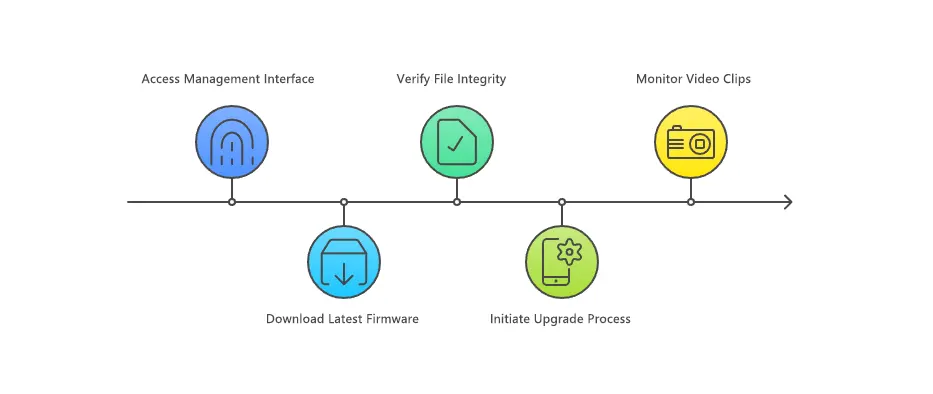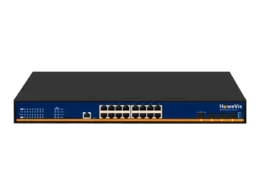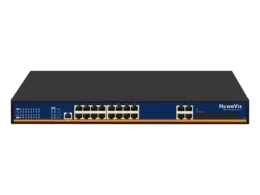POE switch software plays a crucial role in managing network devices. It simplifies power distribution and data transfer, making it essential for modern networks. Many users struggle with outdated systems that lack efficiency. This is where advanced POE switch software comes into play.
It enhances performance and offers features like remote management, monitoring, and extra connectivity. Users can easily configure settings and troubleshoot issues without hassle. The right software not only saves time but also boosts productivity. Say goodbye to clunky interfaces and hello to streamlined operations. With the right POE switch software, you’ll experience a noticeable upgrade in your network’s capabilities.

Key Takeaways
| Key Takeaways: |
| Understanding PoE switch software is essential for optimizing your network’s performance and ensuring that devices receive adequate power and connectivity. |
| Utilizing PoE software can enhance network management by providing better control, monitoring, and configuration of connected devices. |
| Regularly upgrading your PoE switch software can lead to improved security features and support for newer technologies, keeping your network up-to-date. |
| Identify the specific needs of your network to determine when and how to upgrade your PoE software effectively. |
| Consider building your own PoE switch if you need a customized solution that fits your unique requirements and budget. |
| Monitor the upgrade process closely to avoid disruptions and ensure a smooth transition to the new software version. |
Understanding Howevision PoE Switch Software

Definition
PoE switch software is essential for managing Power over Ethernet devices. It helps in controlling power delivery to devices like IP cameras, VoIP phones, and wireless access points. This software allows users to monitor and configure the network efficiently.
With PoE switch software, administrators can ensure that connected devices receive the correct amount of power. This prevents overloads that could damage equipment. The software also provides features for troubleshooting and network monitoring.
L2 and L3 Features
L2 (Layer 2) and L3 (Layer 3) features play a significant role in enhancing network performance. L2 features include switching and VLAN support. These allow for efficient data transfer within the same local area network.
L3 features enable routing between different networks. This is crucial for larger organizations with multiple branches. By using both layers effectively, networks can achieve higher speeds and better reliability.
For example, L2 switching reduces latency by directing traffic only where it needs to go. L3 routing optimizes data paths, ensuring faster communication across networks. Together, they improve overall network efficiency.
Automatic MDI/MDI-X Operation
Automatic MDI/MDI-X operation is vital for seamless connectivity. It simplifies the process of connecting devices to the network. This feature automatically detects the type of cable used and configures the port accordingly.
Without automatic MDI/MDI-X, users would need to manually set up connections based on cable types. This could lead to errors or connectivity issues. Automatic detection saves time and reduces frustration.
For instance, when connecting a device with a straight-through cable, the switch adjusts automatically. If a crossover cable is used, it adjusts again without user input. This flexibility enhances user experience significantly.
Customization Services
Howevision has a professional R&D team to provide you with professional software customization services. Customization allows organizations to tailor PoE switch software according to their specific needs. This ensures optimal performance based on unique network requirements.
With custom solutions, businesses can integrate additional features or functionalities that standard software may not offer. This can include advanced security protocols or specialized monitoring tools.
In summary, understanding PoE switch software is crucial for effective network management. Its role in controlling Power over Ethernet devices cannot be overstated. The significance of L2 and L3 features enhances performance greatly. Automatic MDI/MDI-X operation further streamlines connectivity, making setups easier for users.

Benefits of Howevision PoE Software
Energy Efficiency
PoE software plays a crucial role in energy efficiency. It allows centralized power management for connected devices. This means users can control the power supply to multiple devices from one location. By doing this, they reduce energy waste significantly. Devices only use power when needed, which lowers electricity bills.
Centralized management makes it easier to monitor energy usage. Users can identify devices that consume too much power. They can then take steps to optimize their energy consumption. This is particularly useful in large networks with many devices. Efficient energy use supports sustainability goals as well.
Network Reliability
Advanced features in PoE software enhance network reliability. One key feature is store-and-forward technology. This method stores incoming data packets and checks them for errors before forwarding them. It reduces the chances of data loss during transmission.
Store-and-forward technology also helps maintain network performance. It minimizes delays caused by faulty packets. As a result, users experience smoother connections and fewer disruptions. Reliable networks are essential for businesses that depend on constant communication.
Furthermore, PoE software often includes monitoring tools. These tools allow real-time tracking of network performance. Users can quickly identify issues and resolve them before they escalate. This proactive approach enhances overall network stability.
Simplified Deployment
Deploying IP cameras and other devices becomes easier with PoE software. Traditionally, setting up these devices required separate power sources and wiring. PoE eliminates this hassle by delivering both data and power through a single cable.
This simplifies installation and reduces costs. Fewer cables mean less clutter and easier maintenance. Users can set up devices in hard-to-reach locations without worrying about power outlets.
The intuitive interface of PoE software aids in device configuration as well. Users can quickly add or remove devices from the network. The software often provides step-by-step guides for setup, making it accessible even for non-technical users.
Enhanced Security
Security features in PoE software also improve overall system integrity. Many systems offer encryption methods to protect data being transmitted over the network. This is vital for sensitive information, especially in business environments.
e PoE solutions provide automatic firmware updates. These updates ensure that all connected devices have the latest security patches installed. Keeping devices updated helps prevent vulnerabilities that could be exploited by cyber threats.
-
48 Ports Layer 3 managed POE switch with 4 Ports 10Gbps SFP+
-
Layer 3 Managed POE switch with 24 Gigabit ports and 4 Ports 10G SFP+
-
16 Ports Gigabit Layer 3 Managed POE switch with 4 Ports 10G uplink
-
16 Ports Gigabit Managed POE Switch with 4 Gigabit Combo uplink
-
16 Ports Gigabit Managed PoE Switch with 2 Ports Gigabit SFP
-
Gigabit Managed Ethernet Switch, 24-Ports 10/100/1000Base-TX RJ45, 4 Ports Gigabit Combo Uplink
Howevision Switch Help You Enhance Network Management
Web Management
Web-based management offers real-time monitoring and configuration of networking devices. Users can access their network from any location. This capability allows for immediate adjustments and troubleshooting. A unique graphic user interface simplifies the process. It provides a clear view of network status and performance metrics.
Network monitoring solutions help identify issues quickly. Administrators can see which devices are online or offline. They can also track bandwidth usage across different connections. This proactive approach reduces downtime and enhances overall network reliability.
SNMP Support
Simple Network Management Protocol (SNMP) support is crucial for effective network management. It enables devices to send alerts about their status. These alerts help administrators respond quickly to potential problems. For instance, if a server goes down, an SNMP alert notifies the team immediately.
With SNMP, users can monitor the health of all connected devices. This includes smart Ethernet cameras and other compact networking solutions. The ability to receive real-time data allows for better decision-making. Organizations can optimize their resources based on actual network conditions.
Telnet Applications
Telnet applications play a significant role in remote access to switch settings. They allow users to connect to switches over a network. This connection facilitates changes without being physically present at the device’s location.
Administrators can configure ports, manage connections, and perform diagnostics remotely. This capability is especially useful for organizations with multiple facilities or remote locations. Quick access to settings speeds up troubleshooting and minimizes disruptions.
Backup Solutions
Backup solutions are essential for maintaining network integrity. Regular backups ensure that configurations are saved securely. In case of device failure, restoring settings becomes straightforward.
Organizations should implement backup protocols regularly. Scheduled backups prevent data loss and ensure quick recovery times.
Port Mirroring
Port mirroring enhances network visibility by duplicating traffic from one port to another. Administrators use this feature to analyze data flow without interrupting services. It aids in identifying bottlenecks or unauthorized access attempts.
This functionality is vital for maintaining security and performance levels within the network. By monitoring traffic patterns, teams can make informed adjustments.

Steps to Upgrade Software
Access Management Interface
Accessing the switch’s management interface is the first step. Connect your computer to the network where the switch is located. Open a web browser and enter the switch’s IP address in the address bar. Log in using your credentials. You may need the default username and password if you haven’t changed them.
Once logged in, navigate to the software or firmware section of the interface. This area typically shows the current version of the software running on your switch. Familiarize yourself with this interface to ensure a smooth upgrade process.
Download Latest Firmware
Next, download the latest firmware from the manufacturer’s website. Visit the official site for your specific managed switch model. Look for a support or download section, which usually lists available software updates.
Select the most recent version of the firmware compatible with your device. Click on it to start downloading. Make sure to save the file in an easily accessible location on your computer. The file format may vary but often includes .bin or .zip extensions.
Verify File Integrity
Before proceeding with the upgrade, verify the integrity of the downloaded file. This step ensures that the file is not corrupted or tampered with during download. Most manufacturers provide a checksum value alongside the firmware download.
Use a checksum utility to compare your downloaded file against this value. If they match, you can be confident that your file is intact and ready for installation. If they do not match, re-download the firmware and repeat this process.
Initiate Upgrade Process
After confirming file integrity, return to the management interface of your switch. Locate the firmware upgrade option within the software section. Select it, then browse for your downloaded firmware file.
Follow any prompts displayed on-screen during this process. The switch may reboot automatically after uploading new software. This reboot allows it to apply changes and run on updated firmware.
Monitor Video Clips
Post-upgrade, check if video viewing functionality works as expected. Use remote client software to access cameras connected through your POE switch. Ensure that thumbnails and video clips are loading correctly. This verification helps confirm that both network management and camera functionalities remain intact after upgrading.

Identify Upgrade Needs
Assess Performance
Users should first assess current network performance. This evaluation helps determine if software enhancements are necessary. Slow connections or frequent disconnections signal potential issues. Quality control is crucial in maintaining efficient operations. If the network struggles under heavy loads, it may be time for an upgrade.
Monitoring performance metrics provides valuable insights. Check for bandwidth usage, latency, and error rates. These factors reveal how well the current software meets demands. Regular assessments help in identifying weaknesses.
Identify Features
Next, identify specific features lacking in the existing software version. Users need to understand their requirements clearly. For example, some may need enhanced backup capabilities or improved security protocols. Others might require advanced monitoring tools.
Review the features offered by the latest software versions. Compare them with what is currently available. This comparison highlights gaps that impact productivity. Knowing these specifics aids in making informed decisions.
Monitor Compatibility
Device compatibility is another critical aspect to consider. New software often comes with updated requirements. Users must ensure that their hardware can support these changes. Otherwise, they risk conflicts during upgrades.
Check the specifications of existing devices against those required for new software. This step prevents disruptions in service and maintains network integrity. For instance, Howevision’s professional industrial PoE switch manufacturer provides guidelines on compatible devices.
Consider Thumbnail Identification Help
In some cases, thumbnail identification can assist users in recognizing device status quickly. A clear thumbnail image can indicate whether a device is functioning correctly or needs attention. This visual aid simplifies monitoring tasks.
Utilizing thumbnail identification helps in quick decision-making regarding upgrades. Users can reference these images when assessing device performance. It allows for immediate recognition of any issues that may arise.
Plan for Future Needs
Finally, it’s essential to plan for future needs as well as current ones. Technology evolves rapidly, and networks must adapt accordingly. Understanding potential growth areas helps in selecting suitable software upgrades.
Anticipate changes in user demands or network expansion plans. This foresight ensures that chosen software will remain relevant over time.









